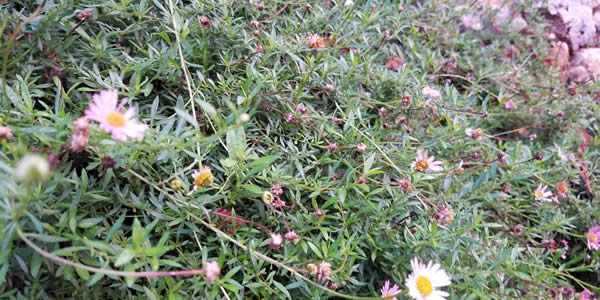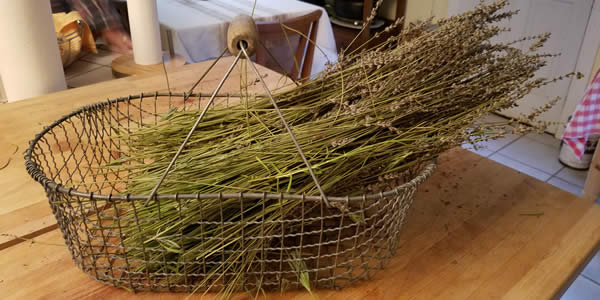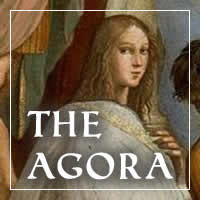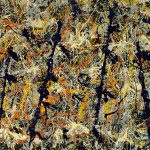Did you think gardening would be like sitting for a cup of tea with Granny on the patio? Those rare and beautiful moments are, believe me, planned and worked toward for days, weeks, if not months ahead of your visit. Especially if your Gran loves to garden.

It is said that a gardener’s shadow is the best fertilizer. This is the time of year I find myself applying large amounts of my own home-spun miracle grow to our planting beds and their various inhabitants. Today, it was the lavender, drying upon the stalk and begging me to bring them in before winter takes all their scent and charm.
On my way, I had to clear the other deadheads, long past prime. Summer had been mild, not the long and searing sunshine that turns our hills to gold in its dog days. Growth in the garden was vigorous all season. Although it is late in harvest and long past the growing season for most of the country, here the rains have arrived and with it fresh new growth for many native plants. One such, known as Fleabane (Erigeron karvinskianus) Santa Barbara Daisy, is a California native that is very well adapted to the climate. To Fleabane, rain = grow!
Fleabane even blooms this time of year. Well, it starts blooming now, and goes for another nine months taking a short break at the height of summer’s heat. It is a drought tolerant landscaper’s favorite. It is also a threshing herb used (among others) in the days before housekeeping included clearing the floor. In fact, it was a good idea to have a little something on the bare earthen floor besides, well, mud. This is why houses have thresh-holds anyway, to hold in the threshing. The pyrethrums in that flower’s pollen help to kill all sorts of fleas and other no-see-ums. I adore this plant in the garden, especially if you don’t mind friendly volunteers sprouting up from time to time.
Yet, this is one of those moments when being a gardener is difficult for a lover of green and growing things. During the quiet of summer’s blaze I might have come out to this corner and cut back the Fleabane as it threatened to overwhelm the neighboring Lavender beside the path. It had volunteered there, filling in a bare spot in the planting bed nicely. That was the first year. The second year it covered the available earth sloping to the path and deck. Even better. This was year four or five. In a photo one would not have seen the lavender at all, only the spent flower stalks.
By this time the delicate tendrils of the Erigeron’s tiny alternating leaves of the daisy had grown to almost 2-1/2’ long. There was lush new growth on the last 6” of the stalk, with nothing but a matted kelp forest of stalks below, climbing around and through the poor smothered Lavendula. So, I did something that only a gardener would do. I cut the Fleabane back to within 6” of the soil, and left the remaining bare stalks to bud leaflets and flowers soon after. I learned to do this in Native Plants class in college. Not all plants can take this sort of treatment, and there are some times of the year that even this one will suffer.
I did this at my own peril, too. This was the act of a gardener, not Wortcunning. You didn’t know there is a difference? Wortcunning would have done this savage clipping back during the summer, which is exactly what I did in many other places in the garden. Either I was tired, or there were too many flowers blooming to cut it back then. Cutting it back now would annoy the Good People, but I had to risk it—being smothered through another growing season and the Lavender would be gone.
I know a few people who really like plants but cannot be called gardeners because they do not have the ability to ‘weed’.
Definition of terms: A “weed” is a plant, any plant, growing in the wrong place. I realize this is not the standard definition of the word, but many of my favorite herbs (including dandelion and plantain) are classified as ‘weeds’. Especially by the makers of broad leaf herbicides intended for those who would grow a monoculture lawn of grass, instead of cultivating a mowable meadow including daisies, violets, and some of the best medicines known to ancient peoples. Here, we are talking about plantain, dandelion and yarrow among other possibilities. All three look lovely in the lawn, and don’t mind a bit of neglect from time to time.
I digress because even the word ‘herbicide’ is horrid. Yet, weeding includes plucking adorable baby plants from dark rich soil and composting them. This is hard for plant lovers to do. Easier to let them grow tall, flower and cast seeds… Hmmmm, easier when?

Gardening includes doing this not just to baby weeds, but whole, sometimes established plants, for the sake of the plan. And no matter how good the plan, over time even those carefully selected and tended specimens will outgrow their allotted spaces. You will have to make hard decisions involving sharp tools. You will not be able to keep your hands, or karma clean while doing this.
As I may have mentioned before, I have hitherto been prohibited by the spirits of the land from gathering flowers in their prime from my garden, unless it be for an altar. This is the condition that was laid upon me when I moved here and began to work and establish the garden some 15 years ago. Today, I had to explain myself as I worked. I also apologized as I continued to trim the long dead flower stalks from the row of lavender bushes. I was reminded of the wildcrafting principle of harvesting only one in three and knew that this refers to fresh flowers or fruit, not these deadheads I cleaned up now.
Then, it seemed to me that I was somehow released from my gesse, and hereafter allowed to harvest flowers from my garden as I would from the wilds: one in three. Of course, there isn’t much blooming right now, the growing season has only just started. My primary concern being for the pollinators, to see that they have enough flowers for food, so they stay in the area. It is a circular relationship. Often too, it is said that the Wee Folk will disguise themselves as butterflies, bees and other flying creatures when they would not let themselves be known.
The weather has turned a bit toward autumnal with rains and temperatures both falling. Honeybees do not like cold, and I wondered aloud if there were any bees left in the garden as I clipped the last of the fragrant stems for hanging. A spider web distracted me and my thoughts were soon elsewhere until I noticed a familiar buzzing nearby. The Lavender beside me had only three blossoms yet in full flower, the last of the season. I could not but take the presence of my little friend as anything but a blessing, and left her these few compact panicles, harvesting all the rest now dry upon their stalks.
And that is the difference between Wortcunning and Gardening. And taking off my garden gloves I wasn’t surprised to find an unexplainable pinch mark on my middle finger, as if a teeny someone were just a bit annoyed. I knew there would be a price…

Patheos Pagan on Facebook.

the Agora on Facebook
Adventures in Wortcunning is published bimonthly on alternate Fridays. Subscribe via RSS or e-mail.
Please use the links to the right to keep on top of activities here on the Agora as well as across the entire Patheos Pagan channel.

















